A Novel Detection Technique for a Chipless RFID System Using Quantile Regression
Abstract
:1. Introduction
2. System Description
Tag Description
3. Quantile Regression for the Peak Detection
4. Numerical Assessment
5. Experimental Validation
6. Conclusions
Author Contributions
Funding
Conflicts of Interest
References
- Costa, F.; Genovesi, S.; Borgese, M.; Dicandia, F.A.; Manara, G.; Tedjini, S.; Perret, E.; Girbau, D.; Lazaro, A.; Villarino, R. Design of wireless sensors by using chipless RFID technology. In Proceedings of the 2017 Progress in Electromagnetics Research Symposium—Spring (PIERS), St. Petersburg, Russia, 22–25 May 2017; pp. 3309–3313. [Google Scholar]
- Jayakrishnan, M.P.; Vena, A.; Sorli, B.; Perret, E. Solid-State Conductive-Bridging Reconfigurable RF-Encoding Particle for Chipless RFID Applications. IEEE Microw. Wirel. Compon. Lett. 2018, 28, 506–508. [Google Scholar] [CrossRef]
- Jiang, T.Y.; Lai, F.P.; Chen, Y.S. Investigation of the bandwidth of resonators for frequency-coded chipless radio-frequency identification tags. In Proceedings of the 2018 27th Wireless and Optical Communication Conference (WOCC), Hualien, Taiwan, 30 April–1 May 2018; pp. 1–4. [Google Scholar]
- Liu, Y.; Yang, X. Chipless Radio Frequency Identification Tag Design with Modified Interdigital Hairpin Resonators. In Proceedings of the 2018 International Conference on Intelligent Transportation, Big Data& Smart City (ICITBS), Xiamen, China, 25–26 January 2018; pp. 645–648. [Google Scholar]
- Habib, A.; Anam, H.; Amin, Y.; Tenhunen, H. High-density compact chipless RFID tag for item-level tagging. In Proceedings of the 2018 International Applied Computational Electromagnetics Society Symposium (ACES), Denver, CO, USA, 25–29 March 2018; pp. 1–2. [Google Scholar]
- Alves, A.A.C.; Spadoti, D.H.; Bravo-Roger, L.L. Bravo-Roger, Optically Controlled Multiresonator for Passive Chipless Tag. IEEE Microw. Wirel. Compon. Lett. 2018, 28, 467–469. [Google Scholar] [CrossRef]
- Hester, J.G.D.; Kimionis, J.; Bahr, R.; Su, W.; Tehrani, B.; Tentzeris, M.M. Radar & additive manufacturing technologies: The future of Internet of Things (IoT). In Proceedings of the 2018 IEEE Radar Conference (RadarConf18), Oklahoma City, OK, USA, 23–27 April 2018; pp. 0447–0452. [Google Scholar]
- Zeb, S.; Habib, A.; Amin, Y.; Tenhunen, H.; Loo, J. Green Electronic Based Chipless Humidity Sensor for IoT Applications. In Proceedings of the 2018 IEEE Green Technologies Conference (GreenTech), Austin, TX, USA, 4–6 April 2018; pp. 172–175. [Google Scholar]
- Abbas, H.T.; Abdullah, H.H.; Mohanna, M.A.H.; Mansour, H.A.; Shehata, G.S. High RCS compact orientation independent chipless RFID tags based on slot ring resonators (SRR). In Proceedings of the 2018 35th National Radio Science Conference (NRSC), Cairo, Egypt, 20–22 March 2018; pp. 69–76. [Google Scholar]
- Costa, F.; Gentile, A.; Genovesi, S.; Buoncristiani, L.; Lazaro, A.; Villarino, R.; Girbau, D. A Depolarizing Chipless RF Label for Dielectric Permittivity Sensing. IEEE Microw. Wirel. Compon. Lett. 2018, 28, 371–373. [Google Scholar] [CrossRef]
- Marindra, A.M.J.; Tian, G.Y. Chipless RFID Sensor Tag for Metal Crack Detection and Characterization. IEEE Trans. Microw. Theory Tech. 2018, 66, 2452–2462. [Google Scholar] [CrossRef]
- Wang, L.; Liu, T.; Sidén, J.; Wang, G. Design of Chipless RFID Tag by Using Miniaturized Open-Loop Resonators. IEEE Trans. Antennas Propag. 2018, 66, 618–626. [Google Scholar] [CrossRef]
- Xie, K.; Xue, Y. A 12 bits chipless RFID tag based on ‘I-shaped’ slot resonators. In Proceedings of the 2017 6th International Conference on Computer Science and Network Technology (ICCSNT), Dalian, China, 21–22 October 2017; pp. 320–324. [Google Scholar]
- Dey, S.; Karmakar, N.C. Towards an inexpensive paper based flexible chipless RFID tag with increased data capacity. In Proceedings of the 2017 Eleventh International Conference on Sensing Technology (ICST), Sydney, NSW, Australia, 4–6 December 2017; pp. 1–5. [Google Scholar]
- Song, J.; Li, X.; Zhu, H. Multiresonator-based chipless RFID system for low-cost application. In Proceedings of the 2017 Progress in Electromagnetics Research Symposium—Fall (PIERS—FALL), Singapore, 19–22 November 2017; pp. 543–547. [Google Scholar]
- Aiswarya, S.; Ranjith, M.; Menon, S.K. Passive RFID tag with multiple resonators for object tracking. In Proceedings of the 2017 Progress in Electromagnetics Research Symposium—Fall (PIERS—FALL), Singapore, 19–22 November 2017; pp. 742–746. [Google Scholar]
- Su, H.H.; Zhang, J.; Tong, M.S. Design of chipless RFID tag based on surface acoustic wave. In Proceedings of the 2017 Progress in Electromagnetics Research Symposium—Fall (PIERS—FALL), Singapore, 19–22 November 2017; pp. 2136–2139. [Google Scholar]
- Dey, S.; Karmakar, N.C. An IoT empowered flexible chipless RFID tag for low cost item identification. In Proceedings of the 2017 IEEE Region 10 Humanitarian Technology Conference (R10-HTC), Dhaka, Bangladesh, 21–23 December 2017; pp. 179–182. [Google Scholar]
- Boussada, A.; Machac, J.; Svanda, M.; Havlicek, J.; Polivka, M. Erroneous reading of information in chipless RFID tags. In Proceedings of the 2017 Progress In Electromagnetics Research Symposium—Spring (PIERS), St. Petersburg, Russia, 22–25 May 2017; pp. 3304–3308. [Google Scholar]
- Mumtaz, M.; Amber, S.F.; Ejaz, A.; Habib, A.; Jafri, S.I.; Amin, Y. Design and analysis of C shaped chipless RFID tag. In Proceedings of the 2017 International Symposium on Wireless Systems and Networks (ISWSN), Lahore, Pakistan, 19–22 November 2017; pp. 1–5. [Google Scholar]
- Lazaro, A.; Villarino, R.; Costa, F.; Genovesi, S.; Gentile, A.; Buoncristiani, L.; Girbau, D. Chipless Dielectric Constant Sensor for Structural Health Testing. IEEE Sens. J. 2018, 18, 5576–5585. [Google Scholar] [CrossRef]
- Polivka, M.; Svanda, M.; Havlicek, J.; Machac, J. Detuned dipole array backed by rectangular plate applied as chipless RFID tag. In Proceedings of the 2017 Progress In Electromagnetics Research Symposium—Spring (PIERS), St. Petersburg, Russia, 22–25 May 2017; pp. 3314–3317. [Google Scholar]
- Javed, N.; Habib, A.; Amin, Y.; Tenhunen, H. Towards Moisture Sensing Using Dual-Polarized Printable Chipless RFID Tag. In Proceedings of the 2017 International Conference on Frontiers of Information Technology (FIT), Islamabad, Pakistan, 18–20 December 2017; pp. 189–193. [Google Scholar]
- Mukherjee, S. Design of compact Ka- band chipless identification tag using HMSIW cavity resonator. In Proceedings of the 2017 IEEE Asia Pacific Microwave Conference (APMC), Kuala Lumpar, Malaysia, 13–16 November 2017; pp. 694–697. [Google Scholar]
- Chen, C.; Chen, Y.; Li, T.; Yu, Y.; Wu, W. A chipless RFID system based on polarization characteristics. In Proceedings of the 2017 7th IEEE International Symposium on Microwave, Antenna, Propagation, and EMC Technologies (MAPE), Xi’an, China, 24–27 October 2017; pp. 324–329. [Google Scholar]
- Liu, J. Joint frequency and time coded chipless UWB-RFID tag for bit data enhancement. In Proceedings of the 2017 7th IEEE International Symposium on Microwave, Antenna, Propagation, and EMC Technologies (MAPE), Xi’an, China, 24–27 October 2017; pp. 74–77. [Google Scholar]
- Sharma, V.; Hashmi, M. Chipless RFID tag based on open-loop resonator. In Proceedings of the 2017 IEEE Asia Pacific Microwave Conference (APMC), Kuala Lumpar, Malaysia, 13–16 November 2017; pp. 543–546. [Google Scholar]
- Pazmiño, E.; Vásquez, J.; Rosero, J.; Pozo, D. Passive chipless RFID tag using fractals: A design based simulation. In Proceedings of the 2017 IEEE Second Ecuador Technical Chapters Meeting (ETCM), Salinas, Ecuador, 16–20 October 2017; pp. 1–4. [Google Scholar]
- Bibile, M.A.; Karmakar, N.A. Detection error rate analysis using coloured noise for the movement of chipless RFID tag. In Proceedings of the 2018 Australian Microwave Symposium (AMS), Brisbane, QLD, Australia, 6–7 February 2018; pp. 1–2. [Google Scholar]
- Bibile, M.A.; Karmakar, N.C. Moving Chipless RFID Tag Detection Using Adaptive Wavelet-Based Detection Algorithm. IEEE Trans. Antennas Propag. 2018, 66, 2752–2760. [Google Scholar] [CrossRef]
- Herrojo, C.; Mata-Contreras, J.; Paredes, F.; Núñez, A.; Ramon, E.; Martín, F. Near-Field Chipless-RFID System With Erasable/Programmable 40-bit Tags Inkjet Printed on Paper Substrates. IEEE Microw. Wirel. Compon. Lett. 2018, 28, 272–274. [Google Scholar] [CrossRef]
- Costa, F.; Borgese, M.; Gentile, A.; Buoncristiani, L.; Genovesi, S.; Dicandia, F.A.; Bianchi, D.; Monorchio, A.; Manara, G. Robust Reading Approach for Moving Chipless RFID Tags by Using ISAR Processing. IEEE Trans. Microw. Theory Tech. 2018, 66, 2442–2451. [Google Scholar] [CrossRef]
- Dullaert, W.; Reichardt, L.; Rogier, H. Improved Detection Scheme for Chipless RFIDs Using Prolate Spheroidal Wave Function-Based Noise Filtering. IEEE Antennas Wirel. Propag. Lett. 2011, 10, 472–475. [Google Scholar] [CrossRef] [Green Version]
- Sharma, V.; Vithalkar, A.; Hashmi, M. Lightweight security protocol for chipless RFID in Internet of Things (IoT) applications. In Proceedings of the 2018 10th International Conference on Communication Systems & Networks (COMSNETS), Bengaluru, India, 3–7 January 2018; pp. 468–471. [Google Scholar]
- Preradovic, S.; Karmakar, N.C. Multiresonator-Based Chipless RFID—Barcode of the Future; Springer: Berlin, Germany, 2012. [Google Scholar]
- Pozar, D. Microwave Engineering; John Wiley & Sons: New York, NY, USA, 1998. [Google Scholar]
- Koenker, R.; Bassett, G. Regression Quantiles. Econometrical 1978, 46, 33–50. [Google Scholar] [CrossRef]
- Han, Y.; Shi, D. A Case Study on Relationship between Mortgage Payment and Income Using Quantile Regression. In Proceedings of the 2009 First International Workshop on Education Technology and Computer Science, Wuhan, China, 7–8 March 2009; pp. 419–422. [Google Scholar]
- Chen, J.; Ding, J. A Review of Technologies on Quantile Regression. Stat. Inf. Forum 2008, 23, 89–96. [Google Scholar]
- Guan, J.; He, Y.; Shi, D. Using Quantile Regression to Analyze the Trend between the Annual Maximum Sea Level and Southern Oscillation Index. Period. Ocean Univ. China 2018, in press. [Google Scholar]
- Koenker, R.; d’Orey, V. Computing regression quantiles. Appl. Stat. 1987, 36, 383–393. [Google Scholar] [CrossRef]
- Fahrmeir, L.; Kneib, T.; Lang, S.; Marx, B. Regression. Models, Methods and Applications; Springer: Berlin, Germany, 2013. [Google Scholar]
- Koenker, R.; Hallock, K.F. Quantile Regression. J. Econ. Perspect. 2001, 15, 143–156. [Google Scholar] [CrossRef]
- Donelli, M.; Robol, F. Circularly polarized monopole hook antenna for ISM-band systems. Microw. Opt. Technol. Lett. 2018, 60, 1452–1454. [Google Scholar] [CrossRef]
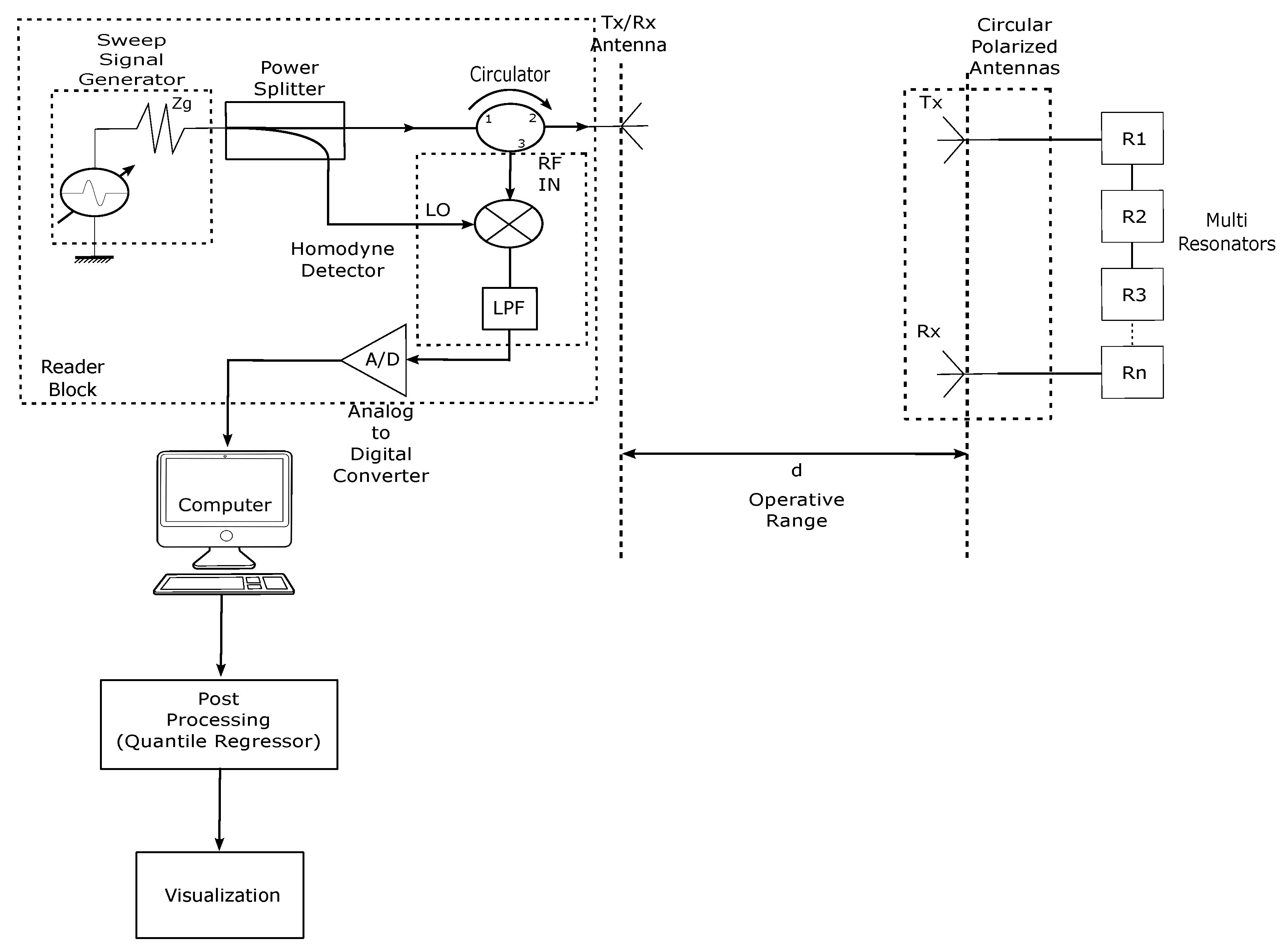
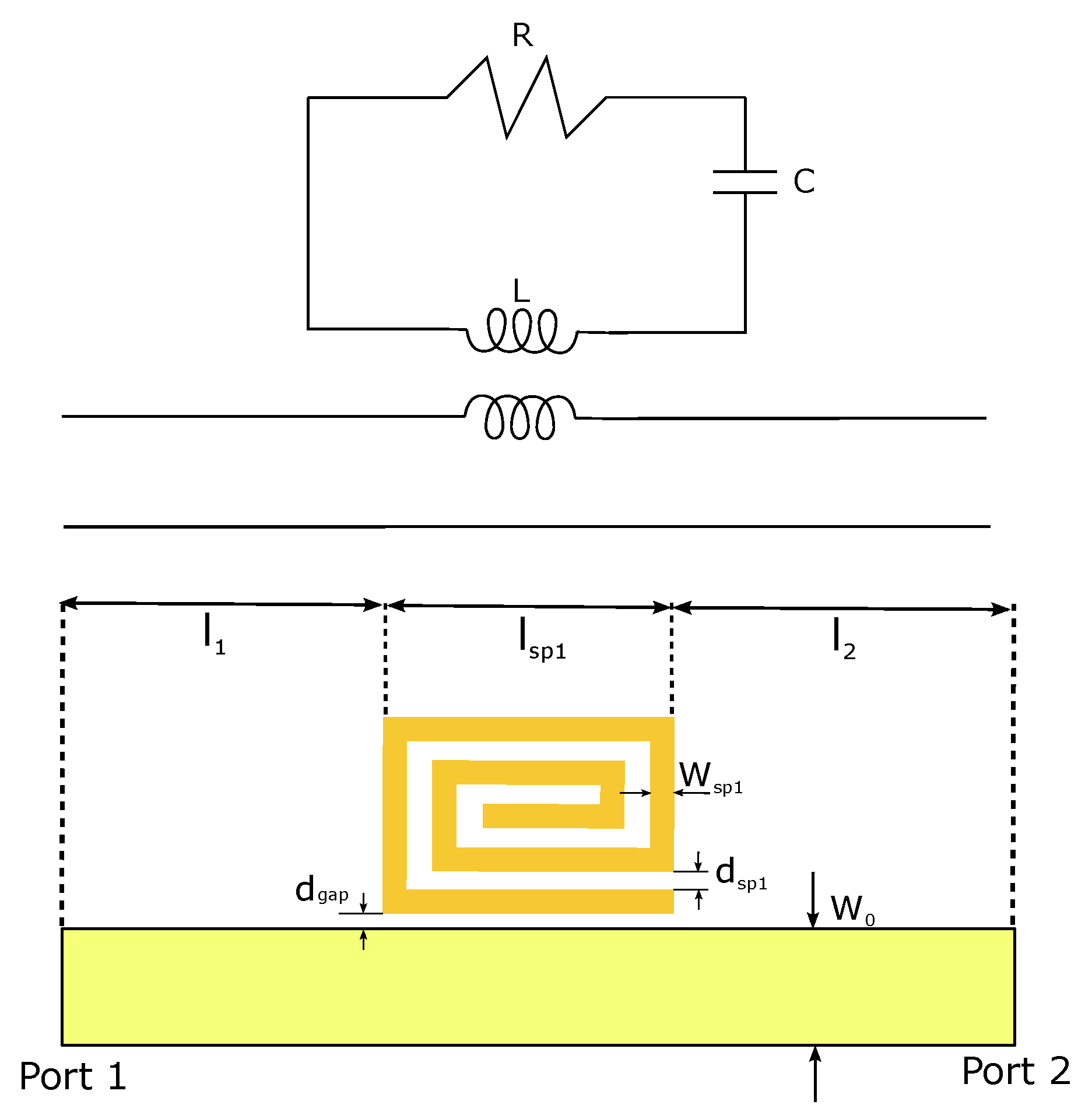
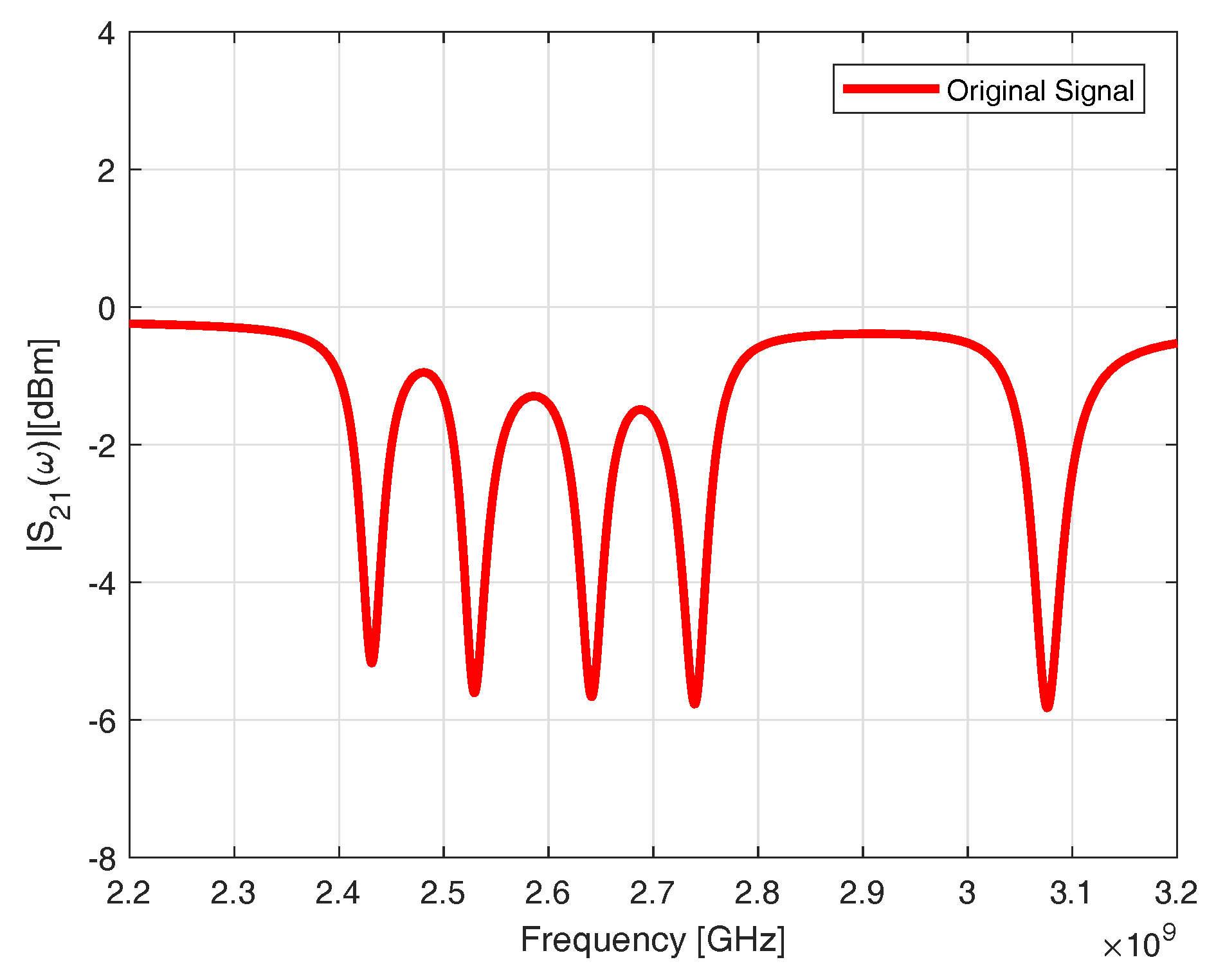

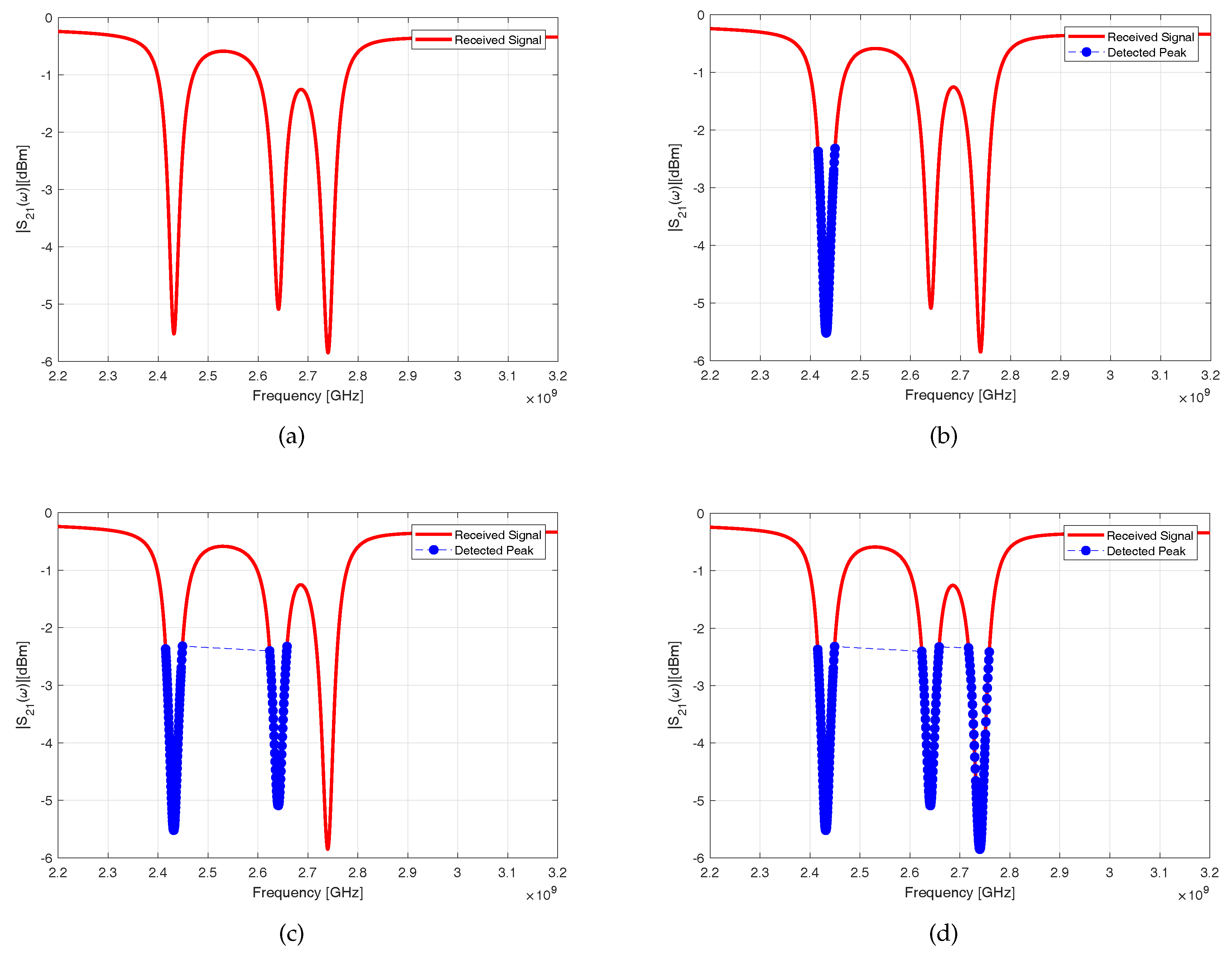
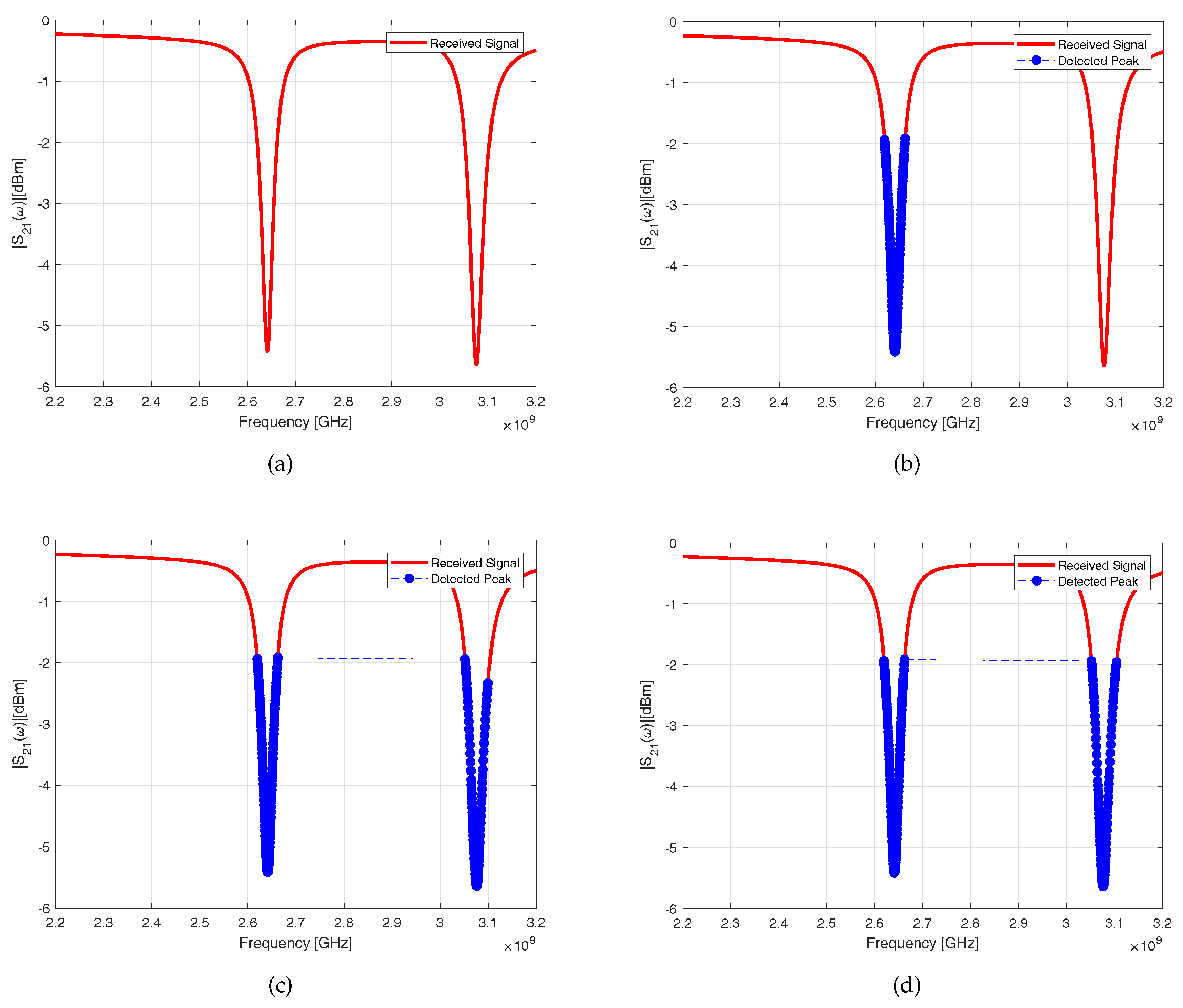


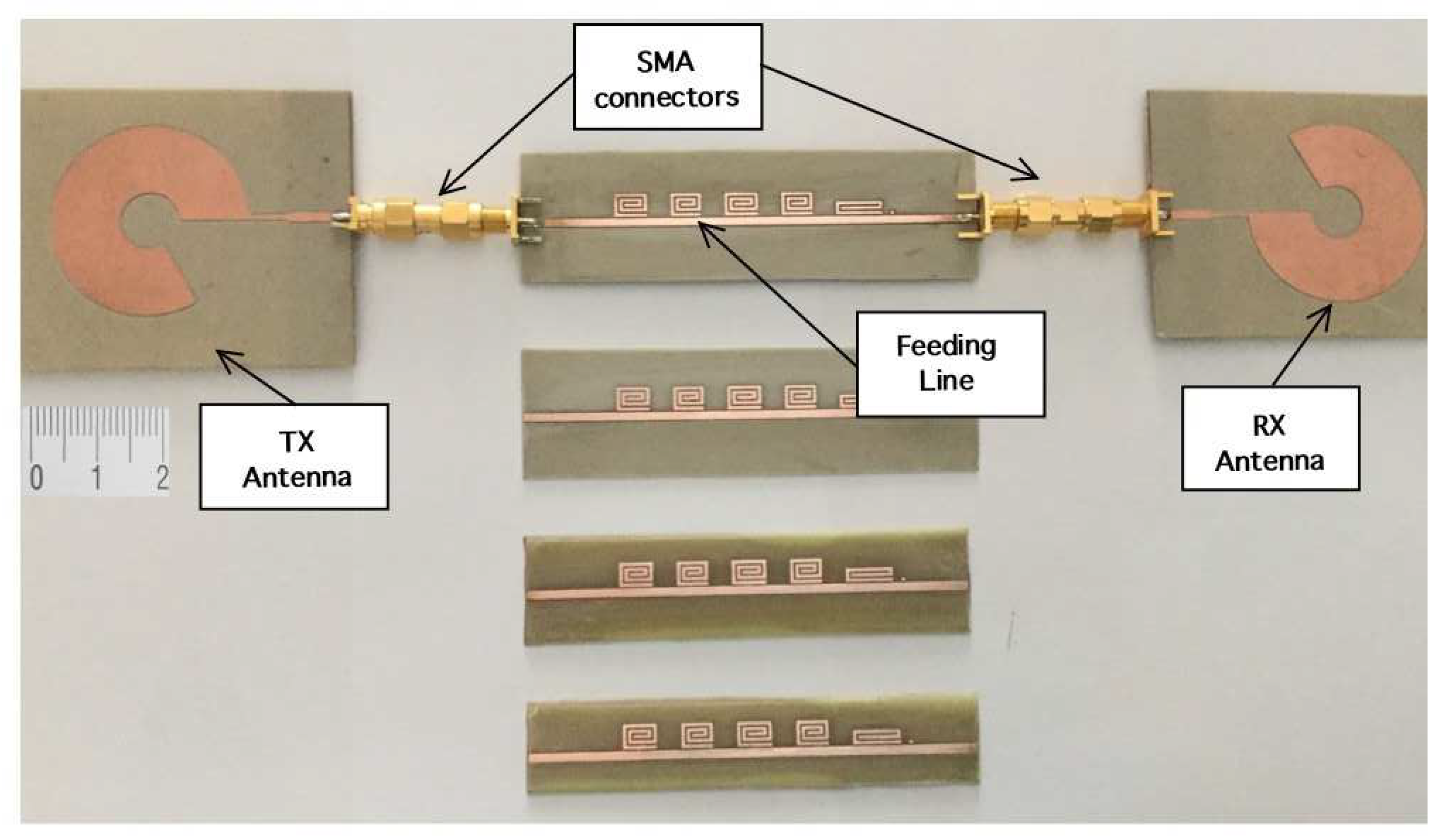
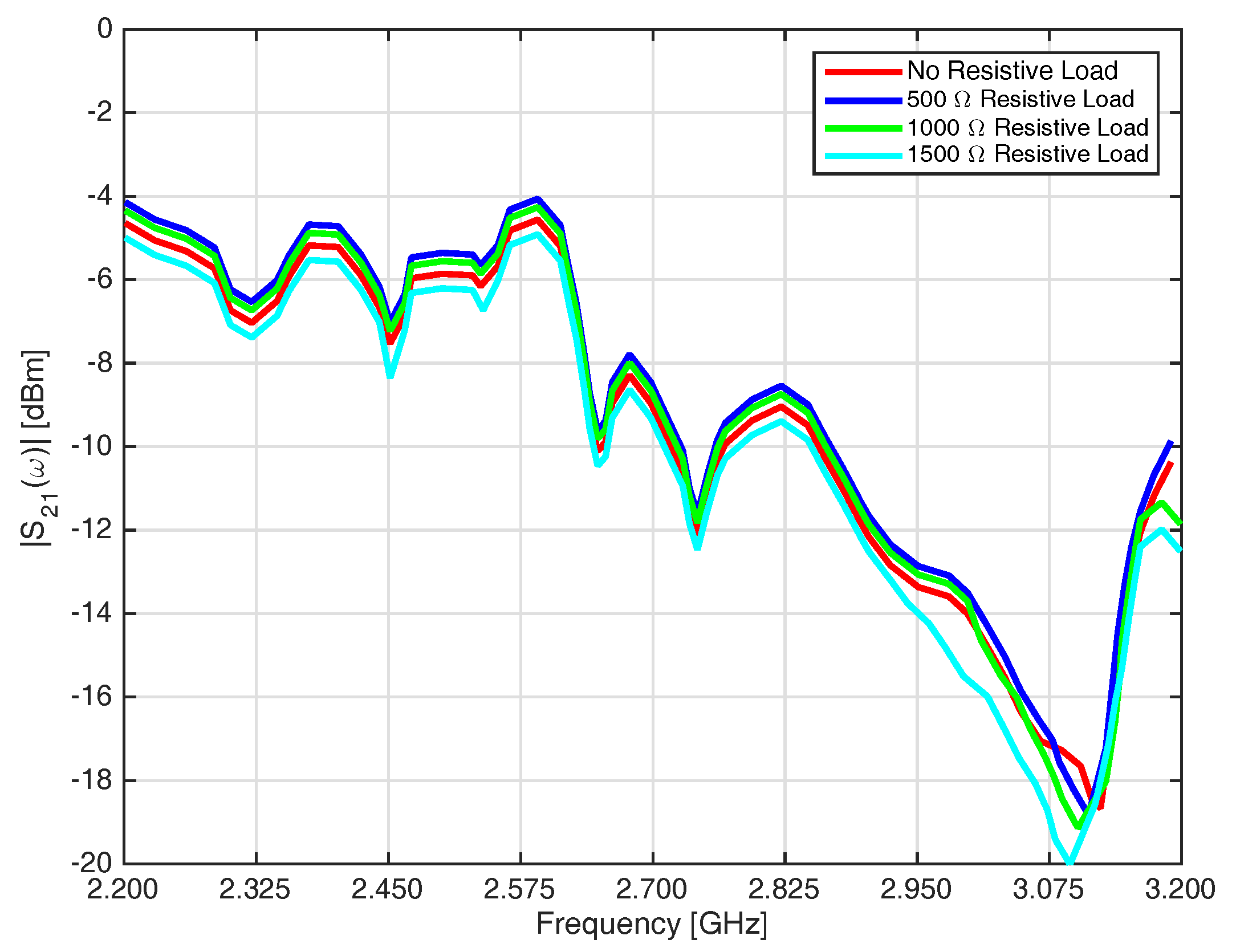
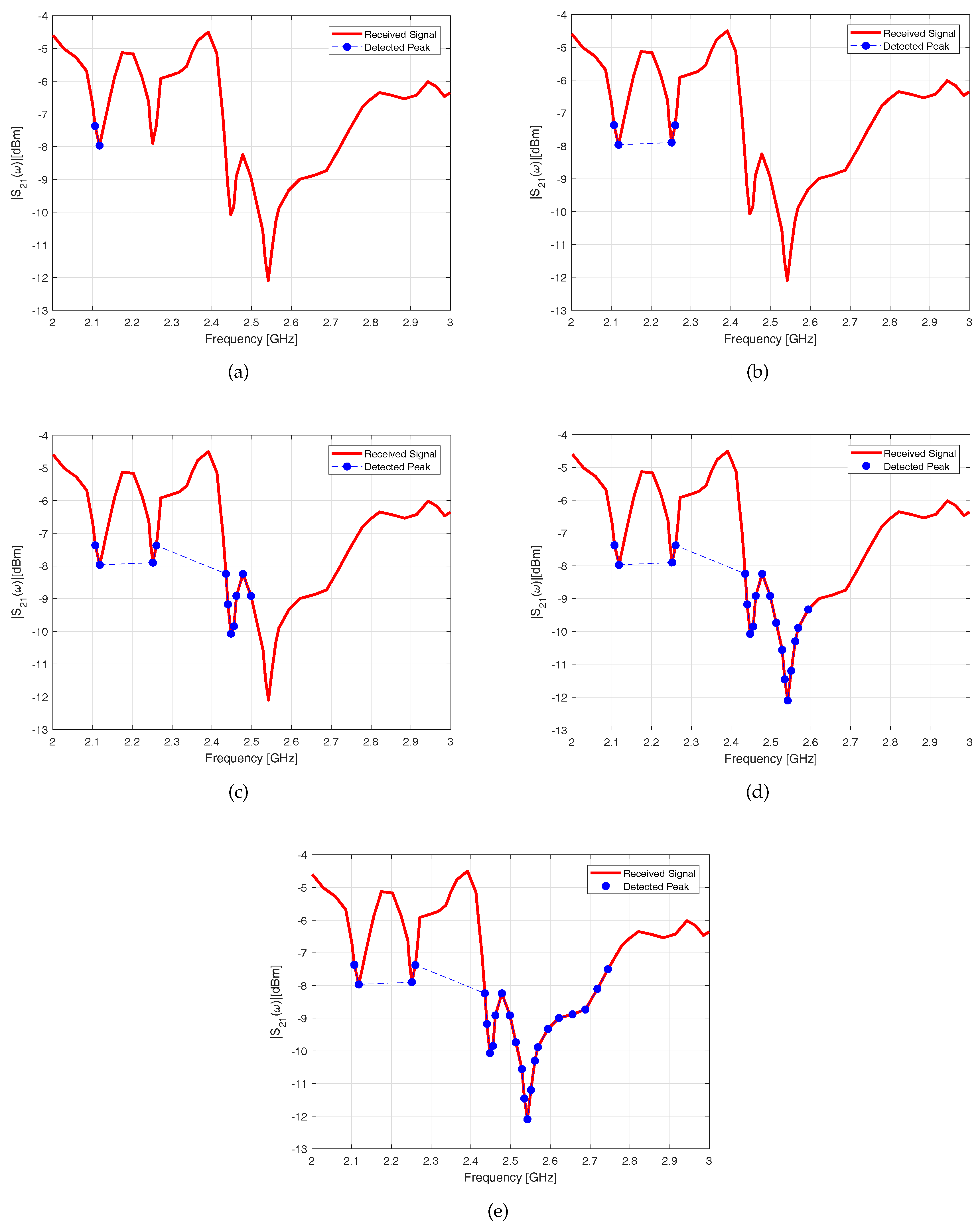

| Resonator | [GHz] | [mm] | [mm] | [mm] | [mm] | [mm] | |
|---|---|---|---|---|---|---|---|
| 1 | 2.4 | 80.1 | 9 | 7.48 | 0.7 | 0.3 | 0.1 |
| 2 | 2.5 | 76.5 | 9 | 7.18 | 0.7 | 0.3 | 0.1 |
| 3 | 2.6 | 73.5 | 9 | 6.9 | 0.7 | 0.3 | 0.1 |
| 4 | 2.7 | 71 | 9 | 6.65 | 0.7 | 0.3 | 0.1 |
| 5 | 3 | 66.3 | 9 | 5.95 | 0.7 | 0.3 | 0.1 |
© 2018 by the authors. Licensee MDPI, Basel, Switzerland. This article is an open access article distributed under the terms and conditions of the Creative Commons Attribution (CC BY) license (http://creativecommons.org/licenses/by/4.0/).
Share and Cite
Manekiya, M.; Donelli, M.; Kumar, A.; Menon, S.K. A Novel Detection Technique for a Chipless RFID System Using Quantile Regression. Electronics 2018, 7, 409. https://doi.org/10.3390/electronics7120409
Manekiya M, Donelli M, Kumar A, Menon SK. A Novel Detection Technique for a Chipless RFID System Using Quantile Regression. Electronics. 2018; 7(12):409. https://doi.org/10.3390/electronics7120409
Chicago/Turabian StyleManekiya, Mohammedhusen, Massimo Donelli, Abhinav Kumar, and Sreedevi K. Menon. 2018. "A Novel Detection Technique for a Chipless RFID System Using Quantile Regression" Electronics 7, no. 12: 409. https://doi.org/10.3390/electronics7120409






